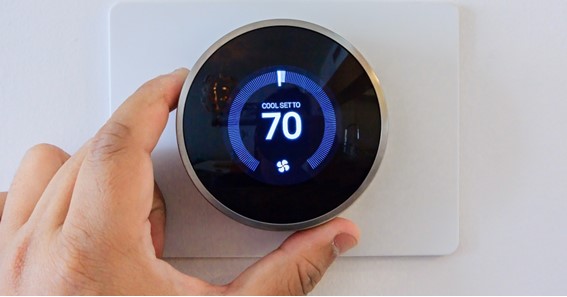In the past, thermostats were basic on/off devices that did not require a dedicated power source. In contrast, wireless smart thermostats with Wi-Fi and backlit displays require a constant source of electricity. The C wire, or “common wire,” permits the thermostat to receive 24 VAC electricity continuously. Technically, electricity flows via the R (red) wire, although intermittently (not on its own, anyway). To make the circuit continuous, a common wire is needed to pass the circuit. When the circuit is complete, constant 24V energy will flow.
If you are contemplating the purchase of a wireless smart thermostat, you are likely planning to install it yourself. In any case, if you can replace a light switch or outlet, you have the skills necessary to install a wireless smart thermostat, provided your system already includes a C wire.
If your system contains a C-wire, it may be in use or concealed beneath the thermostat.
In order to install the majority of current wireless smart thermostat models, you will need to connect a new cable from your furnace to your thermostat if your system lacks a C-wire. Thermostat wire consists of a large spool of color-coded, coiled wires. The “18” indicates the gauge, while the “5” indicates the number of separate wires within the cable. Wire for wireless smart thermostats comes in various weights. If you have heat and air conditioning, you will need 18/5. If you merely have heat, 18/3 is fine, but you may wish to run 18/5 for future-proofing purposes.
Click here – 10 Steps to Take Against Nursing Home Neglect
What Is a C-Wire?
C-wire is an expression for “common wire,” despite the fact that it is not as common as one might assume. By shutting the circuit, steady 24-volt electricity is supplied to the thermostat. The color of the wires in your thermostat, often blue or black, does not reflect their function; it is only a shorthand to make installation easier. The best approach to determine if your system already utilizes a common wire is to remove the thermostat’s faceplate and determine if any wire is attached to the C-terminal. When installing your thermostat, you have the following five alternatives if the terminal is vacant.
HOW TO LOCATE YOUR C-WIRE
If your home has a low-voltage heating system, the C-wire should be located behind the present thermostat. You should be able to remove the thermostat’s cover without difficulty. When you open your thermostat, you may readily identify the C-wire by identifying the wire (often blue) that is linked to ‘terminal C.’ There may be less than five wires, or there may be no wire connected to terminal C. There is a possibility that the wires are concealed within the wall. This circumstance can be evaluated in one of two ways.
Why Do I Require a C-Wire?
Now that you understand what the c wire is, you may be wondering why you need it.
The wireless thermostats of today need more energy than the calculator-screen programmable thermostats of the past.
Maintaining a connection to a WiFi network or automation hub is a nonexistent power demand. Attempting to keep a WiFi connection for several days can deplete a few AA batteries.
Numerous wireless smart thermostats include a huge, full-color touch screen. This is another factor that needs a consistent power supply.
Using a c wire is the best option to give the needed consistent power.
Why is a C-Wire required by a Wireless Smart Thermostat?
Many smart thermostats require a C-wire because they require a continual supply of electricity from the furnace to power the wireless smart components.
Typically, Wi-Fi-enabled wireless smart thermostats can interface with the internet, allowing you to monitor or adjust the temperature remotely. In addition, wireless smart thermostats have a color display that consumes energy.
Unfortunately, batteries cannot deliver sufficient power for a sufficient amount of time to be helpful, thus the requirement for C-wire power from the furnace or boiler.
Not every intelligent thermostat requires a C-wire. Some later types have circuitry that catches the intermittent electricity from the red line in order to charge an internal battery. This allows them to operate without a common wire, which makes installation simpler.
Final Words
Wireless Smart thermostats consume too much energy to be powered by batteries. A c-wire is the ideal solution since it guarantees that your wireless smart thermostat will continue to get electricity as long as your home does.
Click here – What Is ECE Full Form?





